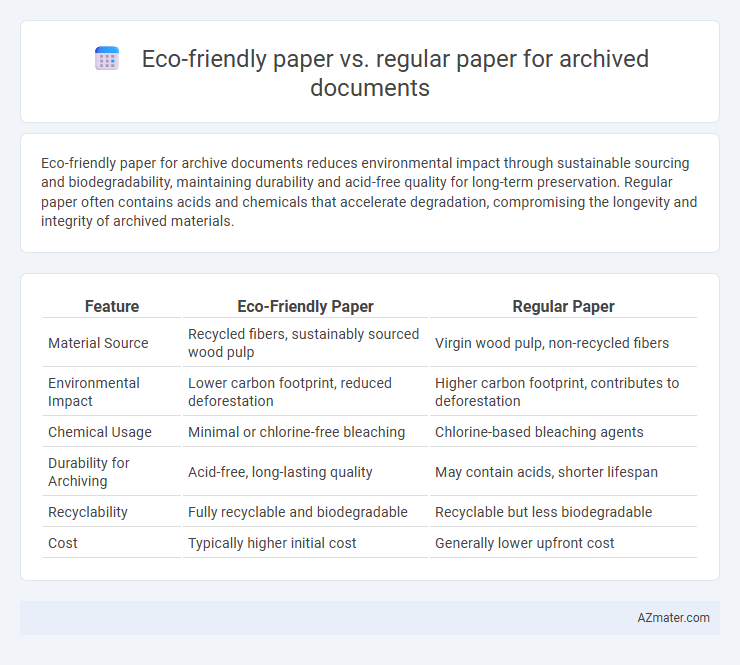Eco-friendly paper for archive documents reduces environmental impact through sustainable sourcing and biodegradability, maintaining durability and acid-free quality for long-term preservation. Regular paper often contains acids and chemicals that accelerate degradation, compromising the longevity and integrity of archived materials.
Table of Comparison
| Feature | Eco-Friendly Paper | Regular Paper |
|---|---|---|
| Material Source | Recycled fibers, sustainably sourced wood pulp | Virgin wood pulp, non-recycled fibers |
| Environmental Impact | Lower carbon footprint, reduced deforestation | Higher carbon footprint, contributes to deforestation |
| Chemical Usage | Minimal or chlorine-free bleaching | Chlorine-based bleaching agents |
| Durability for Archiving | Acid-free, long-lasting quality | May contain acids, shorter lifespan |
| Recyclability | Fully recyclable and biodegradable | Recyclable but less biodegradable |
| Cost | Typically higher initial cost | Generally lower upfront cost |
Understanding Archive Document Requirements
Archive document requirements emphasize long-term durability, acid-free composition, and resistance to yellowing, making paper stability crucial for preservation. Eco-friendly paper is often designed with recycled fibers and environmentally sustainable processes but must meet strict archival standards such as ISO 9706 for permanence. Regular paper may lack these qualities, leading to faster degradation, thus eco-friendly archival paper offers a balance between sustainability and document longevity.
What Is Eco-Friendly Paper?
Eco-friendly paper is produced using recycled materials or sustainable fibers such as bamboo or hemp, significantly reducing environmental impact compared to regular paper made from virgin wood pulp. It utilizes lower amounts of water, energy, and harmful chemicals during manufacturing, which supports carbon footprint reduction and forest conservation efforts. For archive documents, eco-friendly paper offers durability and acid-free qualities essential for long-term preservation while aligning with green building and sustainability standards.
Defining Regular Paper for Archival Purposes
Regular paper for archival purposes is typically made from wood pulp containing lignin, which causes it to yellow and become brittle over time. This type of paper lacks acid-free treatment, leading to faster degradation and posing risks for long-term document preservation. Its insufficient durability and chemical instability make it less suitable compared to eco-friendly, acid-free, and lignin-free papers designed for archival quality.
Environmental Impact: Eco-Friendly vs Regular Paper
Eco-friendly paper significantly reduces environmental impact by utilizing recycled fibers and sustainable sourcing, lowering deforestation and greenhouse gas emissions compared to regular paper. Regular paper production often involves intensive chemical use and higher water consumption, contributing to pollution and resource depletion. Choosing eco-friendly paper supports forest conservation efforts and minimizes carbon footprint, promoting sustainable archival practices.
Longevity and Durability in Archiving
Eco-friendly paper made from recycled materials often lacks the acid-free quality that ensures longevity in archive documents, making regular acid-free paper more suitable for long-term preservation. Regular archive paper is typically produced with lignin-free pulp and buffered with alkaline compounds to enhance durability and prevent yellowing and brittleness over time. The superior fiber strength and chemical stability in traditional archival paper guarantee extended document lifespan and resistance to deterioration, critical for archival longevity.
Cost Comparison: Eco-Friendly and Regular Paper
Eco-friendly paper generally incurs higher upfront costs compared to regular paper due to sustainable sourcing and production methods, although prices have been gradually decreasing as demand grows. Regular paper tends to be cheaper initially but may result in additional expenses over time, such as environmental compliance fees and increased degradation risks impacting archive longevity. Investing in eco-friendly paper can lead to long-term savings by reducing environmental impact, enhancing durability, and aligning with corporate sustainability policies.
Chemical Composition and Preservation
Eco-friendly paper for archive documents is often made from recycled fibers and contains fewer lignins and acids, which significantly reduces chemical degradation over time compared to regular paper. Regular paper commonly includes acidic compounds and bleaching agents that accelerate yellowing and brittleness, compromising long-term preservation. Utilizing acid-free, chlorine-free eco-friendly paper enhances document longevity by maintaining stable pH levels and minimizing harmful chemical reactions during storage.
Certifications and Standards for Archival Papers
Eco-friendly archival paper often carries certifications such as FSC (Forest Stewardship Council) and PEFC (Programme for the Endorsement of Forest Certification), ensuring sustainable forest management. Regular archival papers typically adhere to ISO 9706 standards for permanence and durability but may lack environmental certifications. Selecting archival paper with both ISO 9706 compliance and eco-friendly certifications guarantees long-term preservation alongside environmental responsibility.
User Experience: Handling and Print Quality
Eco-friendly paper for archive documents offers a smoother texture and reduced chemical residue, enhancing handling comfort and reducing smudging during use. Its print quality maintains sharpness and clarity comparable to regular paper, ensuring legibility and professional presentation over time. Users benefit from durable, eco-conscious materials that resist fading and contribute to a sustainable archival solution.
Choosing the Best Paper for Sustainable Archiving
Eco-friendly paper, often made from recycled fibers or sustainable sources like bamboo, offers enhanced durability and reduced environmental impact compared to regular paper derived from virgin wood pulp. For sustainable archiving, selecting acid-free, lignin-free eco-friendly paper ensures longer document preservation while minimizing carbon footprint and deforestation effects. Prioritizing eco-friendly archival paper supports conservation efforts by combining high archival quality with responsible resource management.

Infographic: Eco-friendly paper vs Regular paper for Archive document
 azmater.com
azmater.com